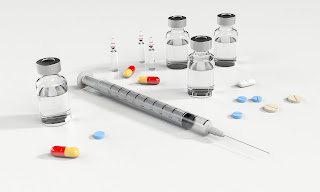Advantage And Disadvantage Of Intravenous (IV) Therapy
Intravenous (IV) infusion or injection is the administration of sterile liquid medication into the body via the vein. Access to the vein is achieved by the use of a syringe through a needle or a needleless port on an existing IV line or a saline lock (short venous access device). It is the fastest means of introducing medication into the systemic circulation.
 |
| Intravenous injection |
Bioavailability of IV therapy is 100%. This is due to the fact that the drug does not suffer the same fate as oral drugs due to the first pass effect. IV are administered as instant bolus or continuous infusion. The drug goes to the right chamber of the heart and then to the lungs before coming back to the right chamber of the heart and of into the systemic circulation.
Read Also: Overview Of Route Of Drug Administration
Any vein can be used. The veins of the forearm and wrist are the most common sites. However, the central IV route which involves placing a catheter located at the outlet of the superior vena cava (right atrium) is used when the solution is hypertonic or requires prolonged therapy.
Advantages Of Intravenous (IV) Therapy
1. Bioavailability is 100% bypassing systemic effect
2. Quick onset of action; therefore, it is the route of choice in emergency, e.g. intravenous diazepam to control convulsions in status epilepticus
3. Large volume of fluid can be administered, e.g. intravenous fluids in patients with severe dehydration
4. Highly irritant drugs, e.g. anticancer drugs can be given because they get diluted in blood
5. Hypertonic solution can be infused by intravenous route, e.g. 20% mannitol in cerebral oedema
6. By i.v. infusion, a constant plasma level of the drug can be maintained, e.g. dopamine infusion in cardiogenic shock
7. Convenience without bitter taste, foul odour, etc associated with oral dosage form
8. Can be given to unconscious patient, elderly and children
9. Drugs that can harm the digestive system can be given IV
Read Also: Overview Of Intravenous (IV) Administration
Disadvantages Of Intravenous (IV) Therapy
1. Once the drug is injected, its action cannot be halted
2. Local irritation may cause phlebitis (Inflammation of the vein)
3. Self-medication is not possible hence require skill train health personnel
4. Strict aseptic conditions are needed
5. Extravasation of some drugs can cause injury, necrosis and sloughing of tissues (leaking if drug into tissues surrounding the vein)
6. Depot preparations cannot be given by IV route
7. Air embolism can occur when air enters the blood circulation
8. Blood clot can occur
9. Only highly soluble drugs can be given IV
10. not for sustained, prolonged, or controlled-release
11. Can be painful
12. Locating the vein for cannulation can be trouble for many people especially the sick and children
13. Expensive in countries like Nigeria as the health personnel may charge the patient for the procedure

Thanks for sharing this wonderful information.
ReplyDeleteDrip Hydration
Many of us may be lacking vitamins without realizing it. The fastest way to restore nutrients to our bodies is with vitamin injections and IV therapies because they bypass the digestive system and enter our bloodstream almost instantly. To know more about iv therapy benefits and the importance of iv therapy, feel free to visit IV Nutritional Therapy in Gainesville or Warrenton IV mineral therapy or Weight loss iv therapy Warrenton VA at Lifestyle Physicians one of the most experienced doctors in Virginia.
ReplyDelete